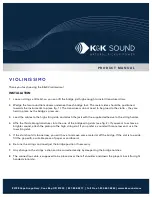
User Manual
User Manual
Ultrasonic Thickness Gauge and Meter
|
D1140772 • D1141137
Ultrasonic Thickness Gauge and Meter
|
D1140772 • D1141137
ULTRASONIC THICKNESS GAUGE AND METER | D1140772 • D1141137
- 16 -
ULTRASONIC THICKNESS GAUGE AND METER | D1140772 • D1141137
- 17 -
6.1. Replace the Battery
6.2. Prevent scratches and wear on the transducer
6.3. Cleaning the device
6.4. Cleaning the calibration piece
6.5.
Clean after each use as coupling agents can cause rust and corrosion.
Avoid impact to the gauge. Keep it stored in the carry case when possible.
6. Maintenance
A.
We you see the low battery icon appear, replace the batteries
1.
Turn off the gauge
2.
Open the access panel
3.
Replace the batteries
B.
When the gauge is not being used for extended periods, remove the batteries.
Since the transducer is made of propylene is can be scratched easily. Be gentle when using on rough
surfaces and do not place it on materials that exceed 60°C, otherwise it may damage the transducer .
Dust and oils that adhere to the transducer can cause a shorter life, so be sure to clean the lead after
each use.
Do not use solvents or alcohol to clean the LCD screen or casing. Only use a moist cloth.
Sound velocities of common materials
Material
Velocity(m/s)
Material
Velocity(m/s)
Aluminum
6320
Acetate resin
2670
Zinc
4170
Phosphor bronze
3530
Silver
3600
Turpentine
4430
Glod
3240
Glass
5440
Tin
3230
Incoloy alloy
5720
Iron/Steel
5900
Magnesium
6310
Brass
4640
Monel alloy
6020
Copper
4700
Nickle
5630
SUS
5790
Steel 4330 mild
5850
Acrylic resin
2730
Steel 330
5660
Water 20°C
1480
Titanium
6070
Glycerinl
1920
Zirconium
4650
soluble glass
2350
Nylon
2620
7. Table of sound velocity




























